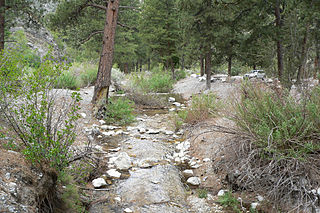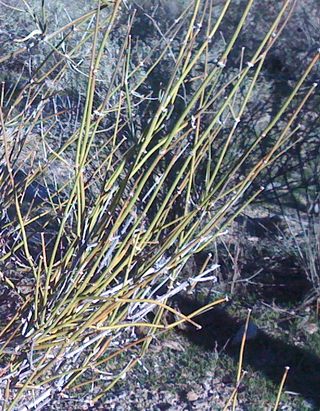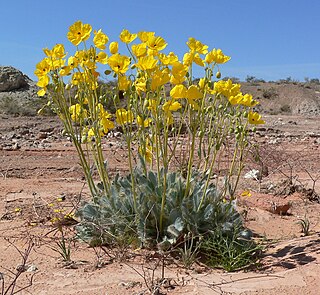
Larrea tridentata, called creosote bush and greasewood as a plant, chaparral as a medicinal herb, and gobernadora in Mexico, due to its ability to secure more water by inhibiting the growth of nearby plants. In Sonora, it is more commonly called hediondilla; Spanish hediondo = "smelly".

Larrea is a genus of flowering plants in the caltrop family, Zygophyllaceae. It contains five species of evergreen shrubs that are native to the Americas. The generic name honours Bishop Juan Antonio Hernández Pérez de Larrea, a patron of science. South American members of this genus are known as jarillas and can produce fertile interspecific hybrids. One of the more notable species is the creosote bush of the southwestern United States and northwestern Mexico. The King Clone ring in the Mojave Desert is a creosote bush clonal colony estimated to be about 11,700 years old.

A clonal colony or genet is a group of genetically identical individuals, such as plants, fungi, or bacteria, that have grown in a given location, all originating vegetatively, not sexually, from a single ancestor. In plants, an individual in such a population is referred to as a ramet. In fungi, "individuals" typically refers to the visible fruiting bodies or mushrooms that develop from a common mycelium which, although spread over a large area, is otherwise hidden in the soil. Clonal colonies are common in many plant species. Although many plants reproduce sexually through the production of seed, reproduction occurs by underground stolons or rhizomes in some plants. Above ground, these plants most often appear to be distinct individuals, but underground they remain interconnected and are all clones of the same plant. However, it is not always easy to recognize a clonal colony especially if it spreads underground and is also sexually reproducing.

Carpenter Canyon is a canyon on the western side of the Spring Mountains, partially within the Humboldt-Toiyabe National Forest, in Clark County, southern Nevada west of the Las Vegas Valley.

The Turtle Mountains, are located in northeastern San Bernardino County, in the southeastern part of California. The colorful Turtle Mountains vary from deep reds, browns, tans and grays, to black. The area has numerous springs and seeps. The Turtle Mountains are also a National Natural Landmark, with two mountain sections of entirely different composition.
This timeline lists events in the external environment that have influenced events in human history. This timeline is for use with the article on environmental determinism. For the history of humanity's influence on the environment, and humanity's perspective on this influence, see timeline of history of environmentalism. See List of periods and events in climate history for a timeline list focused on climate.

Ambrosia dumosa, the burro-weed or white bursage, a North American species of plants in the family Asteraceae. It is a common constituent of the creosote-bush scrub community throughout the Mojave desert of California, Nevada, and Utah and the Sonoran Desert of Arizona and northwestern Mexico.

Methuselah is a 4,854-year-old Great Basin bristlecone pine tree growing high in the White Mountains of Inyo County in eastern California. It is recognized as the non-clonal tree with the greatest confirmed age in the world. The tree's name refers to the biblical patriarch Methuselah, who ostensibly lived to 969 years of age, thus becoming synonymous with longevity or old age in many European languages including English.

The Providence Mountains State Recreation Area is located in the Providence Mountains, within the Mojave National Preserve in San Bernardino County, California. It is also home to the Mitchell Caverns Natural Preserve.

Geraea canescens, commonly known as desert sunflower, hairy desert sunflower, or desert gold, is an annual plant in the family Asteraceae. The genus name comes from the Greek geraios, referring to the white hairs on the fruits.

The Lower Colorado River Valley (LCRV) is the river region of the lower Colorado River of the southwestern United States in North America that rises in the Rocky Mountains and has its outlet at the Colorado River Delta in the northern Gulf of California in northwestern Mexico, between the states of Baja California and Sonora. This north–south stretch of the Colorado River forms the border between the U.S. states of California/Arizona and Nevada/Arizona, and between the Mexican states of Baja California/Sonora.

Ephedra fasciculata is a species of plant in the Ephedraceae family. Common names are Arizona ephedra, Arizona jointfir, and desert Mormon-tea.
The Piper Mountain Wilderness is a federally designated wilderness area located in the White Mountains 20 miles (32 km) northeast of Big Pine, California in Inyo County, California.

The Chimney Peak Wilderness is a 13,134-acre (53.15 km2) wilderness area located 20 miles (32 km) northwest of Ridgecrest, in southeastern Tulare County, California.
The Mopah Range is a desert mountain range, in the Lower Colorado River Valley region, in southeastern San Bernardino County, California.

Arctomecon californica is a species of poppy known by several common names, including California bearpoppy, Las Vegas bearpoppy, golden bearpoppy, and yellow-flowered desert poppy. It is a perennial herb that is native to the eastern Mojave Desert.

The Clipper Mountain Wilderness is a wilderness area in the Clipper Mountains of the eastern Mojave Desert and within Mojave Trails National Monument, located in northeastern San Bernardino County, California. It is under the jurisdiction of the Bureau of Land Management.
Creosote bush scrub is a North American desert vegetation type of sparsely but evenly spaced desert plants dominated by creosote bush and its associates. Its visual characterization is of widely spaced shrubs that are somewhat evenly distributed over flat or relatively flat desert areas that receive between 2 and 8 inches of rain each year. It covers the majority of the flat desert floor and relatively flat alluvial fans in the Mojave Desert, Chihuahuan Desert, and Sonoran Desert. The dominant plants that typify this vegetation type are creosote bush and its associates, white bur-sage, brittlebush, cheese-bush, Mojave yucca, silver cholla cactus, and beavertail cactus. Creosote bush has a wider range than its associates, so codominant shrubs, which are associated with more narrow ranges, will vary from region to region.

Cuscuta denticulata, commonly known as desert dodder or small-toothed dodder, is a thin, yellow to orange, parasitic annual vine in the morning glory family (Convulvulaceae), native to the deserts of the south-western United States and northern Mexico.















